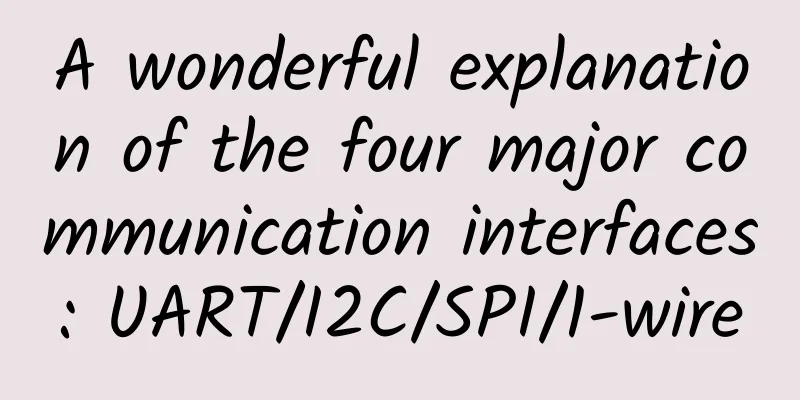A wonderful explanation of the four major communication interfaces: UART/I2C/SPI/1-wire

|
1. Qiu Qianzhang's Light Kung Fu Floating on Water - UART Qiu Qianzhang in The Legend of the Condor Heroes said that UART is my light skill of floating across the river. If you want to cross the river (communication), place hidden stakes in advance, and walk with fixed steps according to the stake spacing (the baud rate is determined in advance). If the step is too big or too small, you will fall into the water. In order not to be discovered by the second brother Qiu Qianren, you can arrange guards to monitor and notify on the other side, and start the performance only when there is no risk (flow control). In order to ensure the accuracy of the stepping point, set a specially marked thick wooden stake at a certain distance. UART Universal Asynchronous Receiver/Transmitter, the communicating parties are connected with three wires, RX, TX and GND, TX is used to send data, RX is used to receive data, the two sides' transceivers are cross-connected, and full-duplex mode is supported. Since there is no clock control, when should we start sending data and ensure that the other party receives it correctly? For example, A sends data to B. When A.TX and B.RX are idle, they keep 1. When A.TX sends 0 as the start bit, it tells B to pay attention and I will send data. Then it starts to send data. The data bit can be configured, usually 5, 6, 7, 8 bits. After a frame of data is sent, A.TX gives a high level to tell B.RX that I have sent a frame. If the check bit is turned on, a check bit is sent before sending the stop bit. Generally, the check bit is not needed. The probability of error in short-distance wired transmission is very small. If there is still data, repeat the previous operation. Generally, the software configures the serial port with baud rate, data bit, stop bit, check bit, and flow control. They represent the transmission speed, the length of a frame of data, whether to stop after sending, whether to check after sending, and whether to control sending. It seems that there are many parameters. According to my personal experience, they are generally fixed with 8 data bits, 1 stop bit, no check bit, no flow control, and only the baud rate is configured. UART does not have a clock to control the timing of data capture. It relies on defining the baud rate before communication. Both parties read and write data bits at the defined frequency. It is just like Qiu Qianzhang's floating on the water. Once the hidden piles are installed and fixed, they have to walk at a fixed step length, otherwise they will fall into the water by mistake. UART can be used in the water floating project, but the transmission efficiency is limited, usually as high as 921600. If it is higher, bit errors may occur. Continuing to increase it means flying at high altitude. In the end, Qiu Qianzhang hoped to walk freely in the sky, and wanted to climb onto the eagle ridden by Huang Rong to escape, but he accidentally fell and died in a flight accident. 2. I2C As the boy who looks after the silver furnace of Taishang Laojun, King Yinjiao knows I2C best. If I call you among thousands of people and you answer, you will be in trouble (communication can only be achieved when the slave address is correct).
IIC (Inter Integrated Circuit) has two lines, a clock line SCL and a data line SDA, so it is half-duplex communication, master-slave mode, and supports one-to-many. One Silver Horn King can deal with a group of monkeys, each monkey has a different name (the I2C address of the slave device is different). Whoever is called by name will be taken away by the purple gold gourd. Assume that the host A sends data to the slave B (A.SCL connects to B.SCL, A.SDA connects to B.SDA). According to the application, A can be connected to B, C, and D at the same time. When idle, the levels on SDA and SCL are both high. Start and stop start condition S: When SCL is high, SDA changes from high to low; stop condition P: When SCL is high, SDA changes from low to high. The start and stop conditions are generally generated by the host. The bus is in a busy state after the start condition, and the bus is idle again after a certain period of time after the stop condition. When idle, the levels on SDA and SCL are both high. A pulls SDA low first, and then pulls SCL low after SDA becomes low (the above two actions constitute the start bit of I2C). At this time, SDA can send data. At the same time, SCL sends pulses of a certain period. The relationship between SDA sending data and SCL sending pulses must comply with: SDA must remain valid when SCL is high, and send the next bit when SCL is low (SCL will sample SDA on the rising edge). Transmission and response: 8 bits of data are transmitted at a time. After the 8-bit data transmission is completed, A releases SDA, and SCL sends another pulse (this is the ninth pulse), triggering B to set SDA to a low level to indicate confirmation (this low level is called ACK). Finally, SCL first changes to a high level, and then SDA changes to a high level (the above two actions are called end marks). If B does not set SDA to 0, A stops sending the next frame of data. Each device on the overall timing I2C bus has a unique address. When transmitting a data packet, the address bit is sent first, followed by the data. An address byte consists of 7 address bits (128 devices can be connected) and 1 indicator bit (7-bit addressing mode), 0 means write, 1 means read. Generally, the I2C address in the chip manual is a 7-bit address, some of which are related to the level of a pin, and the host controls the final read and write bit. Actual projects generally use I2C libraries. Some libraries require an 8-bit write address to be passed in, while others require a 7-bit address. The interface function then distinguishes between read and write bits. Of course, the dumbest way is to read a register address from 0 to 255 in a timed loop. The address when the correct value is read is the correct slave address. In general, when using the I2C library, in addition to configuring the slave address, other start and end timings are not very important. You only need to configure the clock frequency, which generally depends on the maximum supported by the slave and the system clock of the host. If it is too high, errors will occasionally occur. If there is no time requirement, the lower the clock, the more stable it is. 3. Murong Fu's SPI Murong Fu in Tian Long Ba Bu: Although I am not as good as Qiao Feng in using the Eighteen Dragon Subduing Palms, if he attacks me, I will also fight back. When the opponent attacks, he will be attacked back, and we will hurt each other. I can't do anything if he stops the clock. Just like SPI, the host starts the clock to send data, and the slave also outputs at the same time. When the clock stops, everyone stops.
SPI Serial Peripheral Interface (SPI) master-slave mode, a high-speed, full-duplex synchronous communication bus. Standard SPI is 4 lines. SDI (data input), SDO (data output), SCLK (clock), CS (chip select, also called SS). SDO/MOSI – master device data output, slave device data input, master output slave input; SDI/MISO – master device data input, slave device data output, master input slave output; SCLK – clock signal, generated by the master device; CS/SS – slave device enable signal, controlled by the master device. When there are multiple slave devices, the master device selects one of the slave devices for communication through the chip select pin. (I2C is implemented through software protocol, and SPI is implemented through hardware). When the host controls CS and opens the clock gate, the master and slave can start to put or take data bits to interact, but there are standards for when to start. According to the working requirements of the peripheral, the output serial synchronous clock polarity and phase can be configured. CPOL: Clock polarity selection, when it is 0, the SPI bus is idle at a low level, and when it is 1, the SPI bus is idle at a high level. CPHA: Clock phase selection, when it is 0, the first jump edge of SCK is sampled, and when it is 1, the second jump edge of SCK is sampled
There are four modes. Take mode 1 as an example. It is low when idle, and samples at the first clock jump, that is, reading samples at the rising edge, and data is placed at the falling edge. If you really can't tell the difference, there is a stupid way. Try all four modes once, and you will know the correct mode. There is no limit on the number of bits of data transmitted by SPI. As long as the high bit or low bit is defined first, high-speed transmission can be continued. Just as before, if Qiao Feng stopped, Murong Fu would not be able to use the effect of the Eighteen Dragon Subduing Palms, but he could call Qiao Feng a Khitan dog in person, and Qiao Feng would use his power in anger, and Murong Fu's evil plan would succeed. The three words "Khitan dog" are translated into software terms as triggering an interrupt. The slave sends an interrupt to inform the host that I have something to come to me; the host can also query regularly, but it is used less frequently. 4. Qiu Qianchi's stunt of spitting out date pits and 1-wire Qiu Qianchi, the third sister of Qiu Qianzhang, was imprisoned underground. She shot a jujube-core nail with her mouth and hit the jujube tree. The tree would shake and jujubes would fall down to satisfy her hunger. This jujube-core nail is a one-way operation. If you use too much force, the jujube core will penetrate the jujube tree. If you use too little force or miss the target, the jujube tree will not react. In this way, it will be a tragedy when the jujube core is used up. It can be seen that this stunt looks simple, but in fact it hides precise control behind it. The timing and position control must be perfect, such as 1-wire communication, single-line control, and precise clock.
The 1-wire bus interface is simple, only one wire is needed, usually with internal open-drain output and external hardware pull-up. 1-wire uses one line to transmit four types of signaling, including reset pulse and online response pulse reset sequence, write 0 time slot, write 1 time slot, read time slot. Except for the online response pulse, all other signals are sent by the bus master, and all data and commands sent are low-order bytes first. Data communication between the host and the slave is completed through time slots, and only one bit of data can be transmitted in each time slot. Data can be transmitted from the host to the slave through the write time slot, and data can be transmitted from the slave device to the host through the read time slot. The time to complete a bit of transmission is called a time slot. For general operation procedures, please refer to the manual of the peripheral chip, which mainly involves delay processing on different platforms. The software needs to implement a 1us delay interface, otherwise data communication will be abnormal. 5. Secret Skills Each of the four interfaces has a suitable application scenario, and the occupation of hardware ports, control requirements for software, and communication efficiency are also different. In particular, the first three are common protocols, which generally support hardware interfaces, and manufacturers generally provide hal libraries, and the requirements for software developers are gradually reduced. This also leads to the code application being very smooth, but the actual underlying principles are slightly lacking, and once there is a communication abnormality or special needs, it is difficult to start. For example, GPIO is used to simulate UART, and SPI is used to implement AT functions. Martial artists generally seek lost martial arts secrets, just like software developers. When they have problems, they always hope to rely on other people's experience summary, or the manufacturer's technical support or source code, rather than creating new skills. Yue Buqun in The Smiling, Proud Wanderer was the head of the Huashan Sect, proficient in the Purple Cloud Divine Art, and his martial arts were first-class, but he did not continue to focus on his own internal skills, and castrated himself for the Exorcism Sword Manual. Do software developers want to repeat the same mistake? Regardless of whether you are a sword master or a gas master, you should first run the function and then reverse the code principle and implementation process, or first clarify the timing and principle and then code to implement the function. In the short term, the sword master is efficient and gets a quick salary increase; the gas master may be eliminated, especially in a small and snobbish company that does not pay attention to the training of new people. If you combine the two, you can use it when the project is urgent, and study and summarize in your spare time, learning from each other's strengths and making up for your weaknesses, which is the quality of a perfect developer. There is no secret recipe for software development; it all depends on personal learning and summary. This article is reprinted from the WeChat public account "Embedded Systems". You can follow it through the QR code below. To reprint this article, please contact the Embedded Systems public account. |
<<: China's first ISO/IEC artificial intelligence international standard project was approved
>>: 10 Useful HTML File Upload Tips
Recommend
Just now! Canada officially banned Huawei and ZTE 5G equipment, saying they threaten "national security"
Just now, the Canadian government announced a ban...
It took two years for 5G messaging to be officially commercialized. Is that it?
With the development of science and technology, t...
Detailed explanation of the network model splitting in the network. I finally understood it after being troubled for a long time. Take a look at it in one minute
Seven-layer model decomposition From the applicat...
It may be too early to claim that 5G package user development has cooled down
[[384501]] The three major operators all released...
People's Daily pays attention to the speed limit of network disk: Let the speed limit of network disk be increased
On January 21, the People's Daily published a...
The struggle between operators and users: Who decides my package?
What service do you like the most? The most likel...
Maxthon Hosting: 54 yuan/month US CN2 GIA-2GB/30G SSD/500GB/Los Angeles Data Center
Aoyoyun is a long-established hosting company, fo...
Is 5G really green, or will it consume more resources?
The tech industry has long sought to ally itself ...
OlinkCloud: San Jose dedicated server 60% off monthly payment starting at $71.4, triple-network AS9929 line
Olink.Cloud is a site under the old host company ...
8 ways to make Android a powerful productivity tool
【51CTO.com Quick Translation】 According to a surv...
DogYun Hong Kong server monthly discount of NT$100, starting from NT$300 per month, E5-2637v2/16GB/480G SSD/10M bandwidth
DogYun is a Chinese hosting company established l...
Understand the OSI model in five minutes
The Open Systems Interconnection (OSI) model is a...
What are the main reasons why enterprises turn to fiber optic networks?
The invention of fiber optic cables has revolutio...
PTC DPM: Dramatically improving manufacturing efficiency again
According to McKinsey's research report "...









